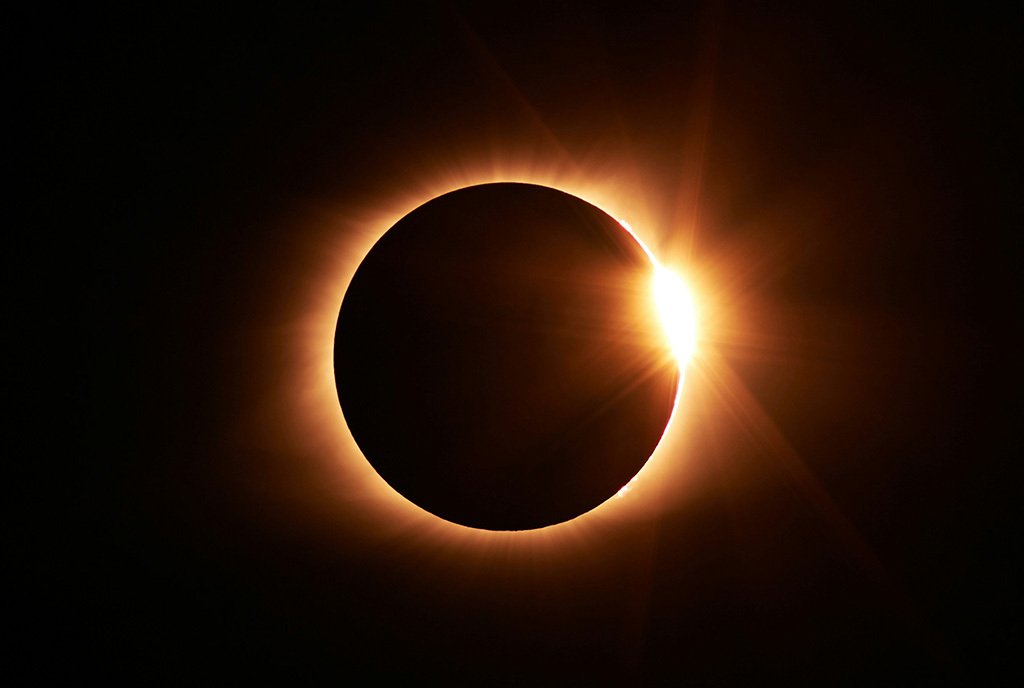
“It is the closest thing to space travel that you can experience without leaving the surface of the earth. Suddenly, the sky that you know is gone…and you can actually look into space toward the center of the solar system. You’re seeing a sky you’ve never seen before.”
That’s how David Baron described a total solar eclipse to Colorado Public Radio. Baron, the scholar-in-residence at the Center for Environmental Journalism housed at the University of Colorado Boulder, has witnessed eight total eclipses, a phenomenon that will be within reach of millions of people on April 8 as the first total solar eclipse in the United States in seven years occurs.
This eclipse is considered special, as The Hill reported; because the moon is closer to Earth, its shadow will be longer. This means viewers “will not only get a glimpse of total darkness but a longer period of darkness as well.” The sun will be blocked by the moon and the sun’s glowing corona will be visible in the sky for over three minutes. “It’s going to be 150 miles across and it doesn’t really get much larger than that,” according to Astronomy and Astrophysics Professor Darren Williams, interviewed by The Hill.
Some schools are canceled on eclipse day for traffic and safety concerns, many special viewing glasses have been sold out for months, and places in the path of totality are preparing for an influx of millions of new visitors. What are nonprofits, communities, and science groups doing to prepare for, and potentially capitalize, on this unusual event? Is the eclipse an opportunity to engage people with nature, encourage them to consider the climate, and take perhaps a first actionable step for climate justice?
Opportunity and Access
That sudden surge of tourists along the path of totality will generate community revenue, but it comes at a price.
According to Forbes, 3.7 million people will travel to the eclipse’s path in order to view the event. States, local governments, and businesses have been quick to try to profit. Vacation companies are offering eclipse tours and cruises costing thousands of dollars. Delta Airlines is flying multiple special flights into the path from Texas to Michigan. The Arkansas House of Representatives has called the upcoming eclipse “the largest tourism event in Arkansas history,” as reported by Forbes.
Many of those travelers are expected to head to state and national parks, where one can view the event in nature. That’s set to generate income for parks in Arkansas, where by December of 2023, 20 of the state’s 21 parks had already sold out of overnight lodging. Mere hours after sales of day passes opened at Dinosaur Valley State Park in Texas, only a few passes remained, and park rangers recommended getting to park viewing locations hours early on the day itself.
That sudden surge of tourists along the path of totality will generate community revenue, but it comes at a price. Roads will be clogged, air pollution from emissions will increase, parking will be difficult, and more trash will accumulate. Many of the communities in the path of totality are small or rural, lacking the infrastructure for the huge crowds expected—and missing the scientific resources of larger cities. And though the eclipse is a nationwide phenomenon, not everyone will have equal access to it: an opportunity to leave work or school to observe the sky, a safe way or place to do so.
Organizations like the Simons Foundation have stepped in with programs and grants to support the smaller, rural communities in the eclipse’s path. The Simons Foundation, which encourages connections between people and science, launched a new initiative that has supported over 50 museums and science centers.
“All of these events require time, planning, and perhaps most importantly, money, something that’s not always available to smaller towns and organizations.”
One of the groups benefiting from the Simons Foundation’s Path of Totality Initiative is the Center for Rural Engagement at Indiana University, which received a $60,000 grant. The center then distributed that grant to 30 small communities around the state, including places like Spencer, IN, with microgrants.
Sign up for our free newsletters
Subscribe to NPQ's newsletters to have our top stories delivered directly to your inbox.
By signing up, you agree to our privacy policy and terms of use, and to receive messages from NPQ and our partners.
Spencer resident Jonathan Balash told Indiana Public Media that the community “didn’t plan, from a financial perspective, well in advance to be hosting thousands and thousands of people at an event mid-year. This is in the middle of our fiscal year here; it would have been a challenge for us.” Instead, thanks to a microgrant, the town has planned free, inclusive, and community building events such as an eclipse photography workshop and a science-themed drag show.
Meanwhile, Shoals, IN, plans to give away 1,000 pairs of eclipse glasses, ensuring as many community members as possible have access to the event. As Indiana Public Media wrote, “All of these events require time, planning, and perhaps most importantly, money, something that’s not always available to smaller towns and organizations.”
These types of small donations can make a big difference. In Vincennes, IN, local science programming will feature advanced technology to allow people who are disabled to experience the eclipse, including a speaker that emits tones that change as the light moves over it.
A Reminder of the Power of Science
Only 57 percent of Americans surveyed “say science has had a mostly positive effect on society.”
Eclipses are introductory-level scientific experiences. You don’t need an expensive telescope, only cardboard glasses (or a box). And by virtue of being relatively easy to understand, they can launch an interest in and appreciation of science. That’s a hope of the Simons Foundation, which wrote “we see this as an opportunity to leverage that sense of wonder to provide onramps for meaningful, lifelong relationships with science that extend beyond this celestial event.”
And that’s a hope of The Conversation, which reported on the work being done by scientists and educators in schools to prepare students for the eclipse—and get a younger generation excited about science. “These efforts demonstrate the universal value of science, and promote science engagement beyond classrooms and institutions,” according to The Conversation.
As Liz MacDonald, citizen science lead for NASA’s heliophysics department, told the Washington Post, “As a scientist, I’m excited by the opportunities that people will experience this and want to experience more. There are many different ways that they could potentially participate with the science.”
At a time of continuing climate emergency, the need to feel invested in science, let alone believe it, has never been more urgent. A 2023 Pew Research Center survey found a continuing American distrust in scientists, with public trust down 14 points since 2020. Only 57 percent of Americans surveyed “say science has had a mostly positive effect on society,” according to the research.
Even sympathetic listeners, viewers, readers—and donors—are increasingly tired of lectures about the climate crisis, the greatest threat to science and our planet. How to convince people to care, to continue to care? The Earth offers its own reminder on April 8. As The Conversation wrote, “April’s total solar eclipse, and others to come, will remind people that science is exciting and inspiring, and that scientific expertise is of profound universal value.”












